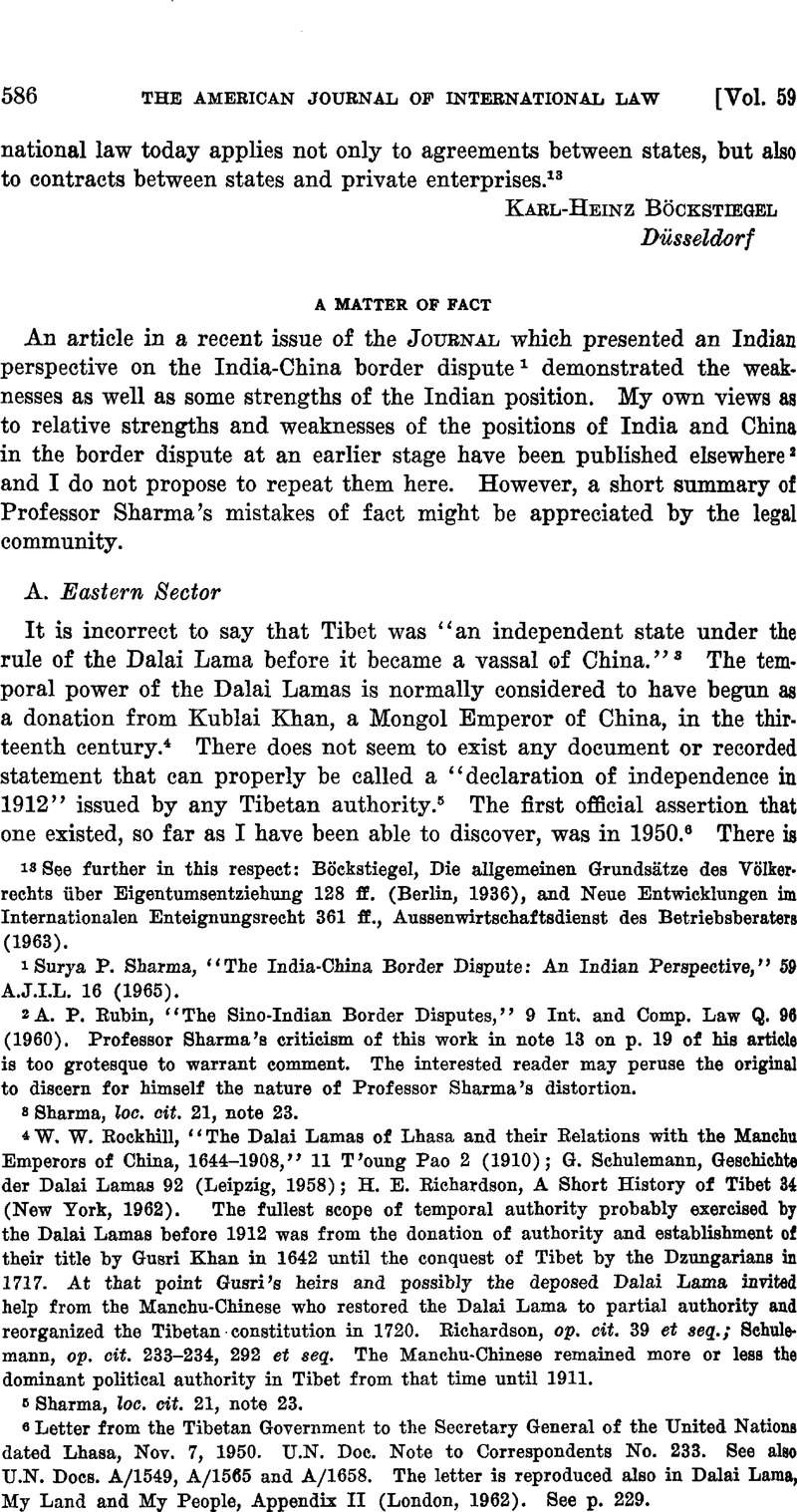No CrossRef data available.
Article contents
Abstract

- Type
- Notes and Comments
- Information
- Copyright
- Copyright © American Society of International Law 1965
References
1 Surya P. Sharma, ‘ ‘ The India-China Border Dispute: An Indian Perspective,'’ 59 A.J.I.L. 16 (1965).
2 A. P. Rubin, “The Sino-Indian Border Disputes,” 9 Int. and Comp. Law Q. 96 (1960). Professor Sharma's criticism of this work in note 13 on p. 19 of his article is too grotesque to warrant comment. The interested reader may peruse the original to discern for himself the nature of Professor Sharma's distortion. s Sharma, Zoo.cit. 21, note 23.
3 Sharma, Zoo.cit. 21, note 23.
4 W. W. Rockhill, ‘ ‘ The Dalai Lamas of Lhasa and their Relations with the Manchu Emperors of China, 1644-1908,” 11 T'oung Pao 2 (1910); G. Schulemann, Gesehichte der Dalai Lamas 92 (Leipzig, 1958); H. E. Richardson, A Short History of Tibet 34 (New York, 1962). The fullest scope of temporal authority probably exercised by the Dalai Lamas before 1912 was from the donation of authority and establishment of their title by Gusri Khan in 1642 until the conquest of Tibet by the Dzungarians in 1717. At that point Gusri's heirs and possibly the deposed Dalai Lama invited help from the Manchu-Chinese who restored the Dalai Lama to partial authority and reorganized the Tibetan ? constitution in 1720. Richardson,op. cit. 39et seq.; Schulemann,op. cit. 233-234, 292et seq. The Manchu-Chinese remained more or less the dominant political authority in Tibet from that time until 1911.
5 Sharma,loo. cit. 21, note 23.
6 Letter from the Tibetan Government to the Secretary General of the United Nations dated Lhasa, Nov. 7, 1950. U.N. Doc. Note to Correspondents No. 233. See also U.N. Docs. A/1549, A/1565 and A/1658. The letter is reproduced also in Dalai Lama, My Land and My ^People, Appendix II (London, 1962). See p. 229.
7 It would be tedious in this place to analyze all reported statements of the Dalai Lama in 1912 to show that none can be fairly construed in context to declare Tibetan independence of China. It may be noted that in 1914 the Lhasa Government of Tibet was prepared to agree publicly that Tibet formed “part of Chinese territory.” See the Schedule of Notes to the Simla Convention of 1914, par. 1, in C. TJ. Aitchison, A Collection of Treaties … , Vol. XIV, at p. 38 (Calcutta, 1929).
8 Sharma,loo. cit. 21-22.
9 Some are cited inibid. 21, note 24.
10 The Chinese rôle in negotiating the 1904 Anglo-Tibetan Agreement was very great indeed. See Parliamentary Papers (U.K.), Cd. 1920 (1904), Cd. 2054 (1904) and Cd. 2370 (1905), passim. Aside from the Nepal-Tibet Treaty of 1856, this is the only agreement cited by Professor Sharma which does not actually have a Chinese signature on it. It was, in fact, signed in the absence of the Dalai Lama but in the presence of the Chinese Viceroy of Tibet in Lhasa and with enthusiastic Chinese approval.
11 Schulemann,op. cit. 355.
12 Sharma,loo. cit. 22.
13 Cf. Aide-Memoire of the British Embassy to the U. S. Department of State dated April 19, 1943, reprinted in TJ. 8. Dept. of State, Foreign Relations of the United States, 1943, China, p. 626 at p. 627 (Washington, 1957); C. P. Fitzgerald, The Birth of Communist China 245 (Baltimore, Pelican, 1964).
14 Sharma,loc. cit. 23.
15 See note 7 above.
16 Quite the contrary. See Alistair Lamb, The China-India Border 145 (London, 1964, hereinafter cited as Lamb). Dr. Lamb's excellent summary of historical fact relating to the border is fully annotated.
17 Ibid. 51-52, 144-145.
18 Sharma,loo. cit. 22.
19 Ibid.
20 Ibid. 23.
21 Ibid. 45.
22 Ibid. 31.
23 The very complex pattern of Tibetan-Chinese assertion of authority, quite possibly amounting to assertions of sovereignty in this area, are admirably laid out in Lamb, pp. 115et seq
24 Ibid. 142et seq., 148et seq.
25 As is sought to be done in Sharma,loc. cit. 32.
26 Ibid. 37.
27 Lamb 153et seq.
28 Sharma,loc. cit. 38.
29 Lamb 46.
30 Report of the Officials of the Governments of India and the People's Republic of China on the Boundary Question, New Delhi, 1961 (hereinafter cited as Report), pp. CB 210, citation no. 45, and CB 211, citation no. 56.
31 Sharma,loc. cit. 25-26.
32 Government of India, Notes, Memoranda and Letters Exchanged and Agreements signed between the Governments of India and China, 1954-1959, New Delhi, 1959 (Vol. III in this indispensable series will be cited below as White Paper III), p. 98.
33 Art. IV.
34 A fair statement of the negotiation on this point is in Report 85. The conclusion drawn in that place from the transaction described seems insupportable. See Chinese Ministry of Foreign Affairs to Indian Embassy at Peking, Note dated Dec. 26, 1959, in White Paper III, p. 60 at p. 63.
35 Sharma,loc. cit. 25.
36 Ibid. 27.
37 Ibid. 29.
38 They are pointed out in Lamb 49-50.
39 Fraser in 1815 (relying mainly on the memory of a single Indian informant rather than his own information); Moorecroft in 1820-1822; Boundary Commissions in 1846 and 1847 (both of which included Cunningham; see Sharma,loc. cit. 34); W. H. Johnson in 1864-1865; The Kashmir Survey in 1868; E. B. Shaw in 1870; Dr. Henderson in 1870; Trelawney Saunders in 1873; Douglas Forsyth in 1873-1874; George Macartney in 1898-1899; and John Ardagh in 1899. These various attempts at definition, and their discrepancies, and the reasons for the discrepancies, are summarized in Lamb 59-87, 100-108.
40 Sharma,loo cit. 34, 36.
41 Ibid. 35.
42 Chinese Ministry of Foreign Affairs to Indian Embassy at Peking, Note dated Dec. 26, 1959, in White Paper III, p. 60 at p. 67.
43 Chou En-Lai to Jawaharlal Nehru, Letter dated Dee. 17, 1959,ibid., p. 52 at p. 54.


